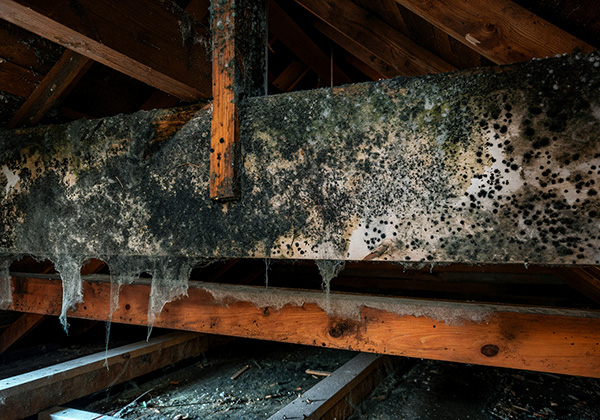Airflow dynamics that make standard soffit vents fail—and how SoffitFlow™ solves the problem.
The Physics of the Problem
Standard Soffit Vents Create the Problems They're Meant to SolveTraditional soffit vents terminate flush with the soffit surface, directing humid exhaust air downward in a vertical trajectory. Basic thermodynamics dictates that this warm, moisture-laden air will rise, following natural convection patterns back toward the roof line.
The problem compounds because building codes require passive soffit vents for attic ventilation—the same vents that provide a direct pathway for exhausted humid air to re-enter the attic space. This creates a closed-loop system where bathroom exhaust never truly leaves the building envelope.
 The Moisture Accumulation Cycle
The Moisture Accumulation CycleOnce humid air re-enters the attic, it encounters cooler surfaces and begins condensing on rafters, insulation, and sheathing. These organic materials provide ideal substrates for mold growth, particularly in climates with high humidity or homes with marginal attic ventilation systems.
The cycle accelerates during peak usage periods—multiple daily showers create sustained moisture loading that overwhelms natural attic ventilation capacity. What appears to be a code-compliant installation becomes a systematic moisture delivery system.
Environmental Factors
Climate and Construction Variables That Amplify the ProblemCoastal regions and areas with high ambient humidity create particularly challenging conditions. When exterior air already carries significant moisture content, the differential between exhaust air and ambient air decreases, reducing natural dispersion rates. This extends the time humid air lingers near intake vents, increasing recirculation probability.
Tight Building Envelopes
Modern construction emphasizes energy efficiency through reduced air infiltration. While this improves HVAC performance, it also reduces natural air exchange that historically helped dilute moisture accumulation. Tighter homes require more deliberate moisture management strategies.
Attic Ventilation Variables
Homes with marginal ridge vent capacity or blocked soffit vents exacerbate recirculation problems. Even properly designed attic ventilation systems can be overwhelmed by direct moisture injection from bathroom exhaust, particularly in multi-bathroom homes with simultaneous usage patterns.
The SoffitFlow Solution
Engineering That Works with Physics, Not Against ItSoffitFlow's fundamental innovation lies in projecting the termination point beyond the fascia line, creating physical separation between exhaust discharge and passive intake vents. This extension breaks the recirculation cycle by ensuring humid air disperses into free air before encountering the building envelope.
The extended nose design creates a positive pressure zone that deflects exhaust air away from the roof line. Instead of relying on natural dispersion alone, SoffitFlow actively directs airflow away from potential re-entry points.
Optimized Airflow Engineering
The precision-positioned 4-inch collar sits toward the rear of the housing, creating an acceleration zone as air flows through the V-shaped tapered bottom panel. This design increases exit velocity, improving dispersion effectiveness and reducing the time humid air remains near the building envelope.
Integrated Performance Features
The gravity-assist damper responds to airflow at 50+ CFM, opening under normal operation and closing when the fan stops. This prevents backdraft during negative pressure events while maintaining optimal exhaust performance. The engineered weep hole manages condensation within the housing, preventing water accumulation that could impact damper operation or create freeze damage in cold climates.
Comparative Performance Analysis
Standard Soffit Vents vs. SoffitFlow PerformanceStandard soffit vents create a vertical discharge pattern that intersects with natural convection currents. Thermal imaging studies show humid air plumes rising directly toward passive intake vents within 18-24 inches of the discharge point. This proximity ensures consistent recirculation under normal operating conditions.
SoffitFlow's extended discharge creates a horizontal airflow pattern that carries humid air beyond the critical recirculation zone. The extended nose positions the discharge point 6-8 inches beyond the fascia line, creating sufficient separation to prevent interaction with intake airflow patterns.
Temperature and Humidity Impact
Exhaust air temperatures typically range from 80-95°F during normal bathroom usage, with relative humidity approaching saturation levels. Standard terminations allow this air to cool and condense before dispersing, creating localized high-humidity zones that persist near the building envelope.
SoffitFlow's extended discharge maintains air velocity longer, promoting rapid mixing with ambient air and faster temperature equilibration. This reduces condensation potential and eliminates the high-humidity zones that drive mold growth.
Maintenance and Longevity
Engineered for Long-Term PerformanceHigh-density polyethylene construction resists the environmental factors that degrade standard termination materials. UV resistance prevents embrittlement, while chemical resistance ensures performance in coastal environments with salt exposure or areas with industrial air quality issues.
The material's thermal expansion characteristics match the operating temperature range without compromising damper operation or housing integrity. This eliminates common failure modes like cracked housings or warped dampers that create callback situations.
Operational Reliability
The gravity-assist damper design minimizes moving parts while ensuring reliable operation across the full airflow range. Spring-loaded mechanisms in standard dampers can fail due to corrosion or debris accumulation, but gravity operation eliminates these failure modes.
The hinged wildlife grill provides necessary protection while maintaining easy access for periodic cleaning. This design balance ensures long-term performance without requiring specialized maintenance procedures.



